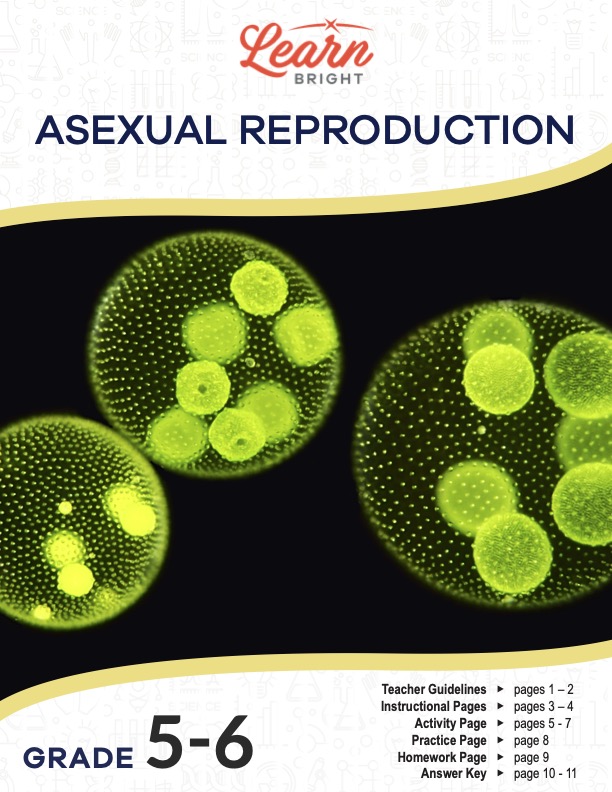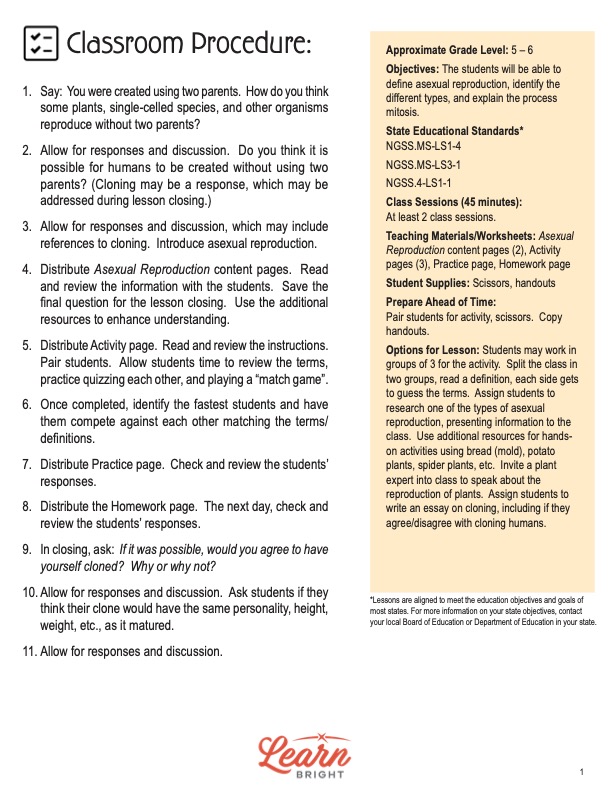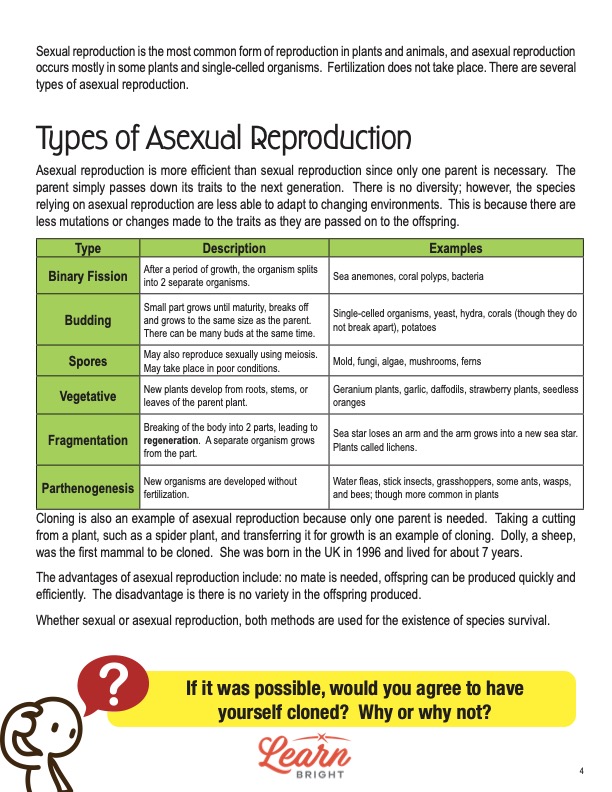Description
What our Asexual Reproduction lesson plan includes
Lesson Objectives and Overview: Asexual Reproduction explores the process of mitosis and how certain organisms in the world reproduce. Students will learn a lot of vocabulary related to the lesson and be able to describe different types of asexual reproduction. They will also discover the difference between mitosis and meiosis. This lesson is for students in 5th grade and 6th grade.
Classroom Procedure
Every lesson plan provides you with a classroom procedure page that outlines a step-by-step guide to follow. You do not have to follow the guide exactly. The guide helps you organize the lesson and details when to hand out worksheets. It also lists information in the yellow box that you might find useful. You will find the lesson objectives, state standards, and number of class sessions the lesson should take to complete in this area. In addition, it describes the supplies you will need as well as what and how you need to prepare beforehand. The only supplies you will need to provide apart from the worksheets are scissors.
Options for Lesson
In the “Options for Lesson” section of the classroom procedure page, you will find several suggestions for activities or tasks that you can add into the lesson. For the activity, you might choose to divide students in small groups rather than pairs. You could also split the class into two groups, read the definitions one at a time, and allow each group a guess at the correct term. Another option is for students to research one of the types of asexual reproduction and present information they gather to the class. To incorporate more hands-on activities, you could look into activities involving bread mold, potato plants, spider plants, and so on. Another suggestion is to invite a plant expert to class to talk about how plant reproduce. One more idea is for students to write an essay on cloning and include their views on whether or not they believe it’s okay to clone humans.
Teacher Notes
The paragraph on the teacher notes page gives you some extra information or guidance on what to expect from the lesson. It reminds you that the nature of the subject matter can be tricky depending on the age or maturity of your students. This lesson also contains a lot of vocabulary words that students are likely unfamiliar with for the most part. You can use the blank lines on this page to write out any thoughts you have as you prepare the lesson for your students.
ASEXUAL REPRODUCTION LESSON PLAN CONTENT PAGES
Reproduction
The Asexual Reproduction lesson plan contains two content pages. Starting off, the lesson describes how every living things reproduces in one way or another. In biology, the definition of reproduction means making a copy or likeness of something so the existence of a species will continue. Without this process, any animal or plant, or other living organism, would die out and no longer exist.
Students will learn that even as they read through these pages, reproduction is happening within their bodies. Skin cells, blood cells, muscle cells, and every other type of cell reproduces continually. As our cells die, they get replaced by new ones through this important process. We don’t even have to do anything to make sure it happens except take care of our bodies.
Generally, people tend to think of parents producing an offspring when they think about reproduction. This applies to a chicken from an, a new flower, or a baby from a human mother. For humans and most plants and animals to produce an offspring, sexual reproduction must take place between two parents. Those parents each contribute one gamete, or sex cell, to the process. While their offspring may look similar to the parents, they will not be exact copies. Sex may be involved, but not always.
Asexual Reproduction
On the other hand, there are many other organisms that reproduce from one parent through a process called asexual reproduction. This process does not involve sex, and the offspring will be an exact copy of the parent organism. In other words, a single organism or cell makes an exact copy of itself, kind of like a clone. The DNA and the genes will be exactly the same. However, there are rare occasions in which a mutation can occur. A mutation is a change in the genetic material that passes on from parent to offspring.
Students will then learn a little bit about mitosis and meiosis. Meiosis, which occurs in sexual reproduction, is a process in which half the chromosomes from each of two parents pass onto an offspring. In asexual reproduction, mitosis occurs, which means all the chromosomes copy and create two identical sets of chromosomes. Then the cell nucleus divides into two identical nuclei. Except for sex cells (male sperm and female ova), mitosis is the process that all other cells in the human body use to duplicate.
The lesson provides two images, one to demonstrate meiosis and the other to demonstrate mitosis. Meiosis shows two cells yielding one offspring that is similar but not exactly the same. Mitosis shows one cell yielding two offspring that are exactly the same as the parent. Sexual reproduction is most common in plants and animals while asexual reproduction occurs mostly in single-celled organisms and some plants. In these cases, fertilization does not happen.
Types of Asexual Reproduction
Asexual reproduction is more efficient since only a single parent is necessary for the process to work. The parent simply passes its traits down to the next generation. However, species that rely on this process are less able to adapt to changing environments. This is because there are fewer mutations or changes made to the traits as they pass from parent to offspring.
There are several types of asexual reproduction: binary fission, budding, spores, vegetative, fragmentation, and parthenogenesis. During binary fission, an organism splits into two separate organisms after a period of growth. Examples include sea anemones, coral polyps, and bacteria. With budding, a small part grows until maturity, breaks off, and grows to the same size as the parent. Yeast, hydra, and potatoes are examples of organisms that reproduce this way.
Spores include organisms like mold, algae, and mushrooms. These can also reproduce sexually using meiosis and are capable of reproducing even in poor conditions. Vegetative is the next type during which new plants develop from the roots, stems, or leaves of the parent plant. Geraniums, garlic, strawberries, and daffodils undergo this type of asexual reproduction.
Fragmentation involves the breaking of the body into two parts, leading to regeneration. A separate organism grows from the part. If a sea star loses an arm, for example, the arm grows into a new sea star. Lichens also behave this way. Finally, parthenogenesis occurs when new organisms develop without fertilization. Water fleas, stick insects, some ants, and bees all reproduce this way, but the process is more common in plants.
Cloning is also an example of asexual reproduction because only one parent is needed. Cutting off a piece of a plant and transferring it elsewhere to grow is an example of cloning. A sheep named Dolly was the first mammal to be cloned. She was born in the UK in 1996 and lived for about seven years!
ASEXUAL REPRODUCTION LESSON PLAN WORKSHEETS
The Asexual Reproduction lesson plan includes three worksheets: an activity worksheet, a practice worksheet, and a homework assignment. Each task will help students demonstrate their understanding of the lesson concepts in different ways. Refer to the guide on the classroom procedure page, which outlines when to hand out each worksheet to the class.
MATCHING ACTIVITY WORKSHEET
For the activity, students will work with a partner. The worksheets provide a list of terms and matching definitions. First, students will review the vocabulary and quiz each other. Next, they will cut out all the terms and definitions and mix them up. One partner will then keep track of time as the other partner works to match the all the cards. Students are welcome to use the content pages to check and review their matches. (You can decide not to allow this if you want to make the game a little more difficult.) For each wrong match, the time tracking partner will add 15 seconds. The winner is the person who matches all the terms with the correct definitions in the least amount of time.
MATCH, COMPARE, AND CONTRAST PRACTICE WORKSHEET
The practice worksheet divides into two sections. For the first section, students will review 15 statements. Using the terms in the word bank on the right, students will match the statements to the correct terms. The second section requires students to compare and contrast sexual and asexual reproduction by listing at least three things that are the same and three things that are different.
ASEXUAL REPRODUCTION HOMEWORK ASSIGNMENT
Similar to the practice worksheet, the homework assignment has several sections. Students will first fill in the blanks to 10 sentences. The options to use are in a word bank below the instructions. Next, students will decide which type of asexual reproduction applies to 20 organisms. The options are binary fission (BF), budding (B), spores (S), vegetative (V), fragmentation (F), and parthenogenesis (P). Finally, the last section requires students to explain the difference between mitosis and meiosis in their own words.
Worksheet Answer Keys
The last couple pages of the PDF are answer keys for the practice and homework worksheets. The correct answers are all in red to make it easier for you to compare them to students’ responses. There may be some variation in student answers for the second half of the practice worksheet and the last prompt for the homework assignment. All other responses should match the answer keys. If you choose to administer the lesson pages to your students via PDF, you will need to save a new file that omits these pages. Otherwise, you can simply print out the applicable pages and keep these as reference for yourself when grading assignments.









